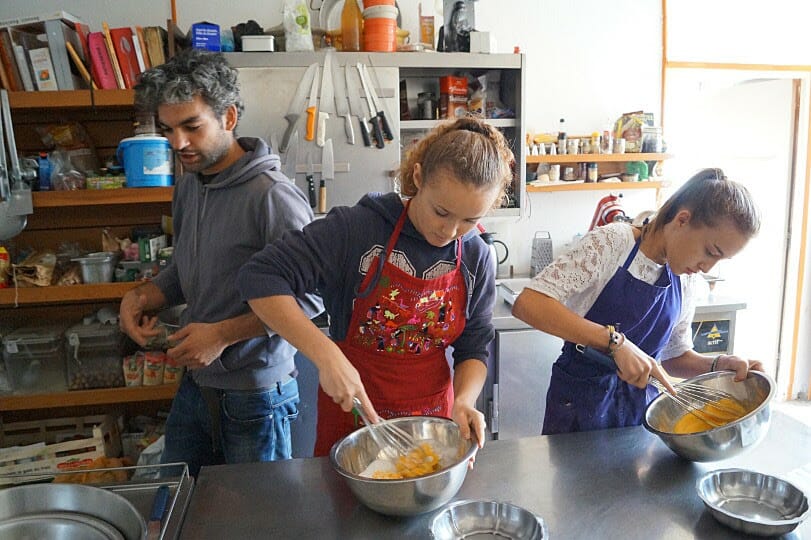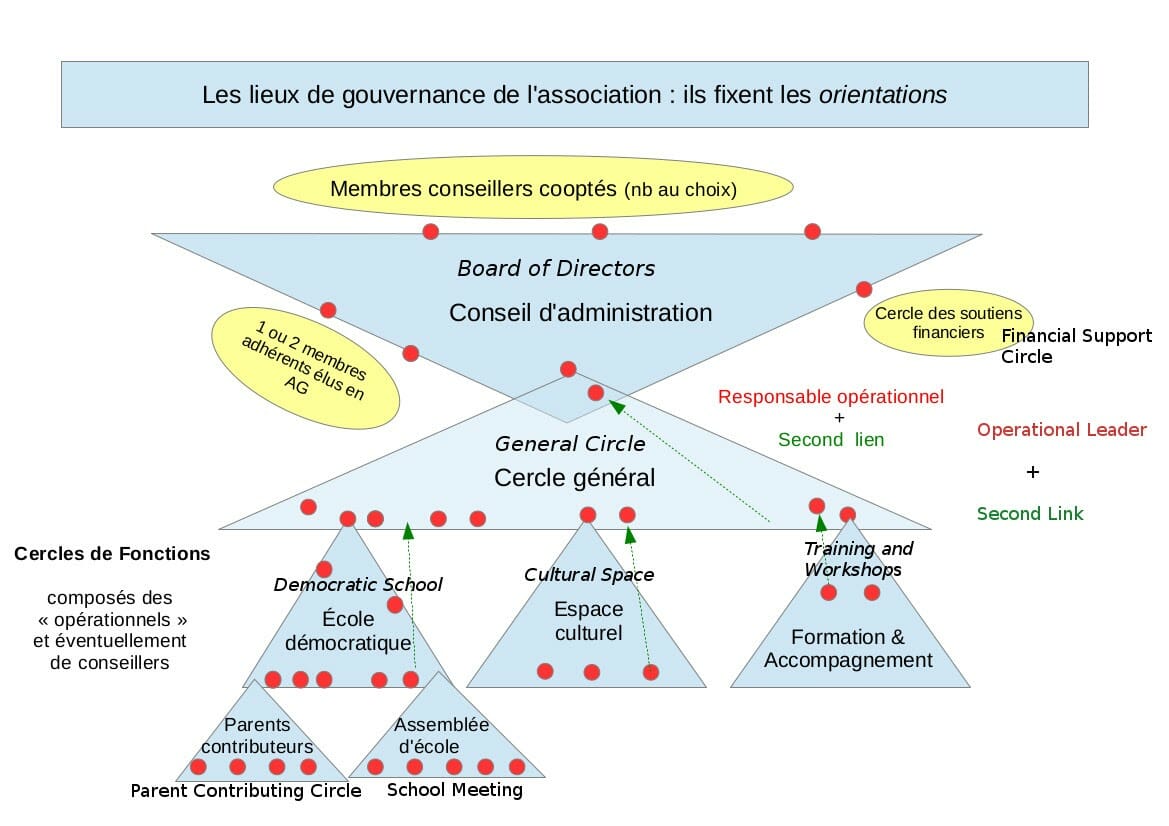Summary
La Croisée des Chemins, or Crossroads, is a cultural center located in Dijon as well as the first democratic free school in France. It was founded in May 2014 and is a school using sociocracy!

The school uses the tools of:
- Sociocracy
- Restorative Circles
- Non-Violent Communication
These structures serve to support collaborative decision making and a person-centered approach to education. The students are involved in decisions that affect the running of the school, including topics such as:
- Daily rules and practices of the school
- How to allocate funding in the budget
- The schedule of the school day
The sociocratic organization also serves as a cultural space and an adult training center, hosting workshops, internships, and training based in a cooperative, person-centered approach.
The group recommends comprehensive and ongoing training and on-boarding in Sociocracy for a robust organization.
The Search for Democratic Schools Using Sociocracy
When I first heard of democratic schools, I was captivated by the utopian vision of children learning democracy from the ground up. The fact that schools exist where children are free to take charge of their lives and have a voice in governing the school sounded too good to be true. I found Sociocracy and wanted to absorb any information I could find in English about using consent-based governance practices in schools, as I had seen firsthand the deficiencies in majority-rules voting in other democratic institutions where the tyranny of the majority often left nearly half of people unsatisfied and unheard. After discovering sociocracy, I got ahold of an out-of-print copy of The Werkplaats Adventure describing the school in the Netherlands that was the birthplace of modern sociocracy, founded on Quaker principles of consent. My hunger for information led me to Europe, where I met Fleur Mathet and Thomas Marshall, who founded a school using sociocracy at the European Democratic Education Conference (EUDEC). Fascinated by their story, I followed up on this case study to make their experiences available to the wider public. I hope to convey what the school is, the practices of the school including communication, governance, and conflict resolution, as well as a sense of how the students participate in the governance. The purpose is to inspire others and to give concrete information about how such a school might operate.
Beginnings
Fleur Mathet, the core founder of the project, is a trained psychologist who homeschooled her own children for a decade. She wanted to create a school that was person-centered and which used collective decision making. However, due to difficulties she had encountered in other collaborative, well-intentioned projects, she was looking for a new set of tools and found Sociocracy on an Internet search. Soon after, Fleur got in touch with Thomas Marshall, Ph.D. in Communications Sciences, who was the secretary of Centre Français de Sociocratie and had thorough training in Sociocracy. In April 2013 the two of them began to build the project together, with the goal of laying firm foundations by starting with a solid framework of Sociocracy to answer the questions: “Who decides what? How do we make decisions together?”
The school opened in May of 2014 with 2 staff and 3 students and has grown to, in November of 2017, 9 staff members and 20 students.
Educational Model and Collaborative Tools
Educational model
Ecole de la Croisee des Chemins is the first democratic free school in France that was inspired by the models of the Sudbury Valley School and Summerhill. Students may choose how to spend their time, and have a voice in making the rules of the school, as well as how to spend the school resources. There are hundreds of democratic schools worldwide, connected through mutually supportive networks.
Non-violent communication
The founding staff was extensively trained in non-violent communication before the school began. The staff seeks to identify and define observations, feelings, and needs as they arise in student conflict, and to use the common vocabulary to aid each person to take responsibility for their feelings. There is no formal “instruction” in NVC, students practice NVC by living it.
Restorative circles
The primary tool for when a rule is broken by school members is to assemble a restorative circle. Restorative circles are a conflict resolution process that seeks to discover what happened, how it affected people or caused harm, and what the people in the situation will commit to doing in order to repair the damage done.
Implementing Sociocracy
For La Croisée des Chemins, sociocracy was used from the beginning in the founding documents of the bylaws. The vision and mission were decided, and the circle structure was drafted as a framework for the organization. At first, there were not many people involved and the circles were all comprised of the same few people. But the circle structure reflected in the diagram below helped the group organize, separate tasks and roles, and remind team members what to focus on in different meetings. Most of the initial organizational policies were drafted by either Thomas or Fleur, and it took a while for others to become more involved in the process. Facilitating participation in decision making was a challenge for several reasons. Learning Sociocracy and stepping into leadership takes an investment in time and energy that was difficult for new members.
How does the organization work?
The Board of Directors acts as the “top circle” of the association, with a limited scope of responsibility. It meets annually to set the strategy for the organization and ensures it is keeping to the vision. Membership includes two members of the General Circle, two members elected by General Circle who are involved in any other circle of the organization, and outside advisory members who bring connections and experience to the table. There are currently very few members of this circle, and there is hope that the Board will grow in the future to ease the burden on heavily invested members of the group and to increase community support.
The General Circle is responsible for coordinating the concrete implementation of the missions of the association, which includes the democratic school, but also a training center, and a cultural space. Topics that cut across the functional circles are discussed here, such as issues with the physical space, finances, and human resources. Currently, the 10 staff members of the school make up the membership of both the Democratic School Circle and also the General Circle.
Functional Circles:
- Training Circle & Consulting Circle conducts training and workshops.
- Cultural Space Circle hosts events for the wider public.
- The Democratic School Circle is made up of the members of the school staff and conducts necessary tasks for the running of the school.
The Democratic School Circle has two “daughter” circles:
The School Assembly, meeting weekly, and open to all students and staff members present, is empowered to decide the rules, the budget, and matters pertaining to the daily functioning of the school. The Assembly is run as a circle and takes all decisions by consent inside its domain.
The circle has passed proposals to purchase a scooter, a sewing machine, and a trampoline with school funding. The rules for using these supplies are still evolving and are changed as needed via consent-based decision making. The School Assembly can be double-linked with the Democratic School Circle if students want to bring a proposal that is in the domain of the School Circle.
The Parent Contributing Circle, a newly-formed circle in 2016, is an optional and non-decision making circle that organizes the parents who wish to help out with the school via volunteer contributions, including offering workshops such as cooking sushi or speaking a foreign language. There is also a little store at which parents can donate goods to be sold for the benefit of the school. The parents do not have the same consent decision making powers as students and staff, and sociocracy is not implemented strongly in this circle.

Circle Decisions In Action: With Students
Students at Croisee des Chemins can – in theory – participate in all the circles. In practice, though, they seldom participate outside the weekly School Assembly that has the most influence on their daily lives. The Assembly is run as a circle and all decisions are made by consent.
The proposals are written on a specific paper form available to all and displayed on a wall so that every member can see topics and decide to attend the meeting or not. Most students participate strategically only if they feel strongly about a proposal.
Students are not required to attend but, if they do, they are allowed to use art materials quietly which helps with focus and concentration on the meeting. Because of optional attendance, the Assembly is generally a smaller group, which helps facilitate consent decision making.
In 2015, some teenage students made the proposal in Assembly to reduce the school week from 5 days to 4 days, whilst increasing the duration of each day. As parents were directly affected, the School Assembly did not have the power to decide this alone. Two students were elected by the Assembly to bring the proposal to the Democratic School Circle level. After a period of testing and consultation with the parents, the proposal was adopted. The school is still operating on a 4 day-per-week schedule as of 2017.
Students are generally highly invested in the consent-based decision-making process, as well as the core value of consent. The founders reflected that it is more difficult to train adults in the process than children. The founders speculate that adults are more familiar with more “authoritarian” rule in other contexts and that assuming shared power is more difficult if you are not used to being empowered.
In 2017, a teenager and a member of the staff team were co-chairs of the Assembly.
Recommendations for other startup groups implementing Sociocracy
Early on, it was difficult to recruit Board members, and there were divisions as disagreements arose about power and the vision of the organization. Thomas said it might have been beneficial to have more solid conflict resolution strategies in place from the beginning before disagreements arose. Fleur related that it is difficult to empower people who are used to top-down power structures to raise objections and communicate problems rather than turning against the person they see as having “power-over” rather than “power-with.” That said, the person-centered approach and Non-Violent Communication used throughout the organization has helped people to listen to what’s going on inside when others begin to feel powerless or angry. A specific time for “measurement” is important, and in this intention, the monthly group supervision facilitated by an external psychologist helps a lot to improve relations and support personal & team growth.
The founders reflected that it is important to have someone who is truly trained with sociocracy – who has a whole comprehension of the process, not only a tool but a way of considering collective organization and collective power. All the tools are new to everyone and ensuring the communication of sociocracy in a way that different learning styles can understand its importance. Recently Thomas devised visual charts and diagrams that help onboard interns and staff members not previously trained in sociocracy who are visually oriented, and they seem to be helping with the learning process.
In the future, the group hopes to grow into a government-funded Laboratory School. A government-funded school with the purpose of experimenting with new practices in education, training teachers, and research and analysis of teaching methods. The school hopes to operate with state-certified teachers, continuing its focus on collaborative decision making and a person-centered approach.
Fleur Mathet and Thomas Marshall were interviewed for this case study.
References: How-to manual on restorative practices in the classroom

